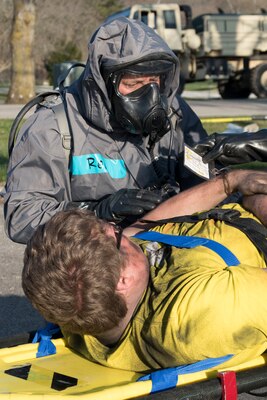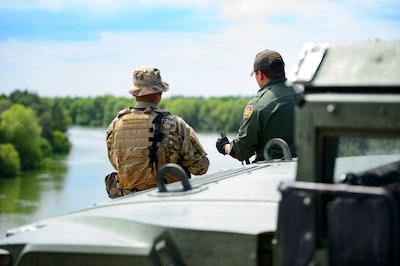By Army Sgt. Brad Mincey 108th Public Affairs Detachment
CAMP ATTERBURY, Ind., April 17, 2018 — It seems like a
disaster here, but fortunately, it isn’t real.
More than 400 South Carolina Army National Guard soldiers
are participating in the U.S. Northern Command-hosted Guardian Response
exercise here through April 30. They’re joined by over a thousand other
soldiers from the National Guard and reserves, supporting civil authorities for
the training. Guardian Response is conducted in conjunction with the U.S. Army
North-sponsored Vibrant Response exercise.
Exercise participants react and respond to a variety of
scenarios in a mock nuclear event, where terrorists detonated a 20-kiloton
dirty bomb in a generic U.S. city.
Working Together
Army Maj. Gen. Michael Stone, Task Force 46 commander and a
Michigan National Guard member, held a mock press conference April 10 to kick
off the exercise. "Task Force 46 serves as the command and control of the
Chemical, Biological, Radiological and Nuclear Element Bravo, coordinating
efforts in case of a catastrophic event in the United States," Stone said.
"Most of the members of Task Force are citizen-soldiers, ready to help
their neighbors recover and get back to a sense of normalcy as soon as
possible."
Task Force 46 consists of Element Alpha (Army Reserve
troops) and Element Bravo (National Guard forces) from eight states across the
U.S. Assets include medics, chemical companies, engineers and other soldiers
who are trained to respond to a variety of natural and man-made disasters.
One of the primary units working with TF 46 as Element Bravo
was the South Carolina Army National Guard's 218th Maneuver Enhancement
Brigade. The 218th MEB brought engineers, medics and chemical companies under
their command, but also had engineers with the Indiana National Guard working
with them during this exercise.
Weapons of Mass Destruction Event
"Our mission is to be a first responder to a weapons of
mass destruction event here in the United States," said Army Col. Robert
Carruthers, commander, 218th MEB. "Our two primary missions are technical
search and rescue into an area that's been affected, and mass decontamination
and medical care of the civilian population."
Guardsmen have to be certified and validated annually
because of the complexity of their disaster-response mission.
"This training is critical because it is a nonstandard
mission for us," Carruthers said. "We have our main mission, which is
our warfighting mission. But this is an additional mission we have as
guardsmen, to protect the homeland. Not a lot of people appreciate or
understand that the National Guard also has this homeland defense and response
mission in which we respond to natural disasters or terrorist events. That is
equally important to the warfighting, but to those at home, this mission may be
more important than the overseas mission."
Army Sgt. Kyle Everett, a combat medic with Company B, 1st
Battalion, 118th Infantry, 218th MEB, agreed that this training was atypical of
what he normally trains for.
Combat Medics
"I'm used to combat medic training with my unit,"
Everett said. "What we are doing here would be training for in state, so
we are treating our own citizens, civilians instead of our battle buddies to
our left and right. So, it's a little different from what I'm used to
normally."
Many of the soldiers involved were looking forward to
training for scenarios that they have not experienced as well as working with
units whom they were unaccustomed to collaborating with.
"I was looking to see a level of training that I
haven't seen before," Everett said. "I was looking forward to working
with a chemical company, because I've never worked with them before or a
hospital unit. And working and treating civilians was really gratifying. This
was very beneficial for us and I think we accomplished our mission to our
utmost ability."
In order to do the training correctly and to be able to get
an idea of what it would feel like in a real scenario, soldiers use the
facilities like Muscatatuck Urban Training Center, here, where the ability
exists to recreate almost any scenario soldiers may face in a disaster.
Training ‘Has Gone Exceptionally Well’
"The training has gone exceptionally well,"
Carruthers said. "The facilities are so advanced and so realistic. In
fact, some of the most realistic we have seen. This is why they choose this
spot, because they can simulate what it would look like in a real scenario.
It's the closest thing you will ever do, short of a real event."
Although many of the skills used in the warfighting mission
transfer over to homeland protection and recovery, there are other skills that
guardsmen will only use in case of a disaster. And, there’s specialized
equipment -- commercial and medical pieces -- that soldiers would only use in
the event of a homeland attack or other disaster. All of this adds up to make a
cohesive group of military and civilian teams that train together and are prepared
to respond to a disaster.
"The camaraderie has been the best part of this
training," said Army Sgt. Larmarion Williams, a firefighter with the 264th
Engineer Battalion, South Carolina Army National Guard. "As we go in, we
have to work with each other and we rely on each other. So this allows us to
know what each of us are capable of. But we all have the same goals: let's get
in, get the job done, get out and make sure the job is done without anyone
getting hurt. We want everyone to go home the same way they came."
The guardsmen and reservists serve a vital role in stateside
emergencies like the one in this simulation, serving in support of civilian
authorities. The military brings capabilities that provide emergency medical
relief, mass casualty and decontamination services, evacuation and ambulatory
care, search and rescue assets, and assist other government authorities
providing relief to affected citizens.
Ready to Respond
"Our primary mission is to respond to [chemical,
biological, radiological and nuclear] and [defense support of civil
authorities] operations in support of civilian authorities when we have mass
incidents in the U.S.," said Army Maj. Brandon Pitcher, executive officer
with the 218th MEB. "We are a maneuver enhancement brigade and we do
mission command for subordinate battalions. Under us, we have chemical
decontamination, search and rescue teams, firefighters, medical teams, and we
have a battalion of engineers."
Because South Carolina and other states’ guardsmen
continually train individually and as groups, they are quickly able to plan,
prepare, move out, set up and take action when, and if, the need arises.
"We have set up a mass casualty decontamination line to
save lives and minimize human suffering to casualties who were exposed to the
simulated nuclear detonation," said Army Maj. David Blackmon, commander of
the 251st Area Support Medical Company, South Carolina Army National Guard.
Casualty roll players are bused in, form lines and are triaged based off of
seriousness of injuries. Next, they are checked out by medics to diagnose what
is wrong. Then, they are sent through decontamination by the chemical company
and lastly attended to by additional medics.
However, since casualties can come in at any time, not just
during daylight hours, soldiers changed shifts and continued to provide the
same level of care after sunset.
‘It’s Been a Great Experience’
"It's been really good and it's been a great experience
because we have been traveling up to Maryland conducting quarterly sustainment
training," Blackmon said.
In addition to the military training soldiers receive at
advanced individual training, many of the unit's soldiers are in school
training to be physicians assistants, nurses and paramedics, so they already
have hands-on training and experiences to deal with these situations.
Once soldiers from the 218th MEB have completed their
training here, they will conduct quarterly training and ensure every unit and
every individual is ready.
"Hopefully that day never comes," Carruthers said,
"but we must continue to prepare in our normal training throughout the
year in order to be ready to respond."








